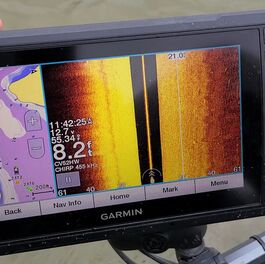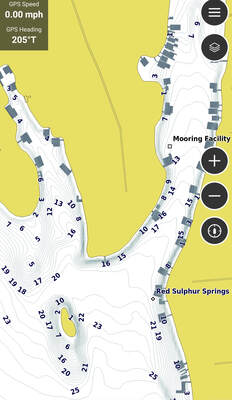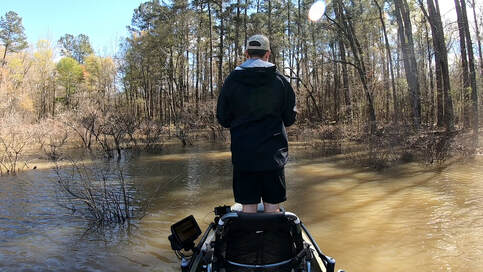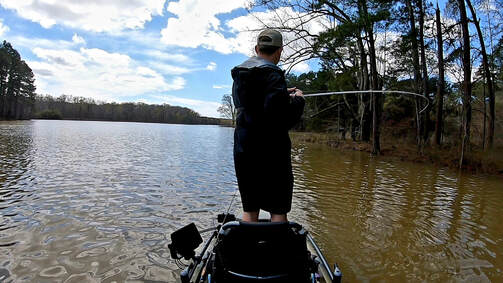|
If I could do a quick search to see how many times this question has been asked on social media, I would assume the number would be astronomical. Are they bedding yet? Every fishing enthusiast from every corner of the country anticipates the day their local lakes fish flock to the shorelines. It’s exciting times and an awesome opportunity to hook into a fish of a lifetime.
Is It Go Time Yet They aren’t necessarily cut and dry, and personally I think we as fisherman tend to rush the spawn before they are ready. What do I mean? Here in the southeast region of the country, we can have very sporadic weather. Starting in late February and early March we will begin to have short spurts of warm weather, followed by longer waves of cold weather and often flooding rain. Moving into late March and early April we’ll see longer warm spells with cold snaps thrown in the mix. Then finally in mid to late April we begin to see warm weather settle in for good. But what does all this do for the water temps and the spawn? If you think about it, the shallows are mostly affected by these weather transitions. Backs of pockets and flats will fluctuate in temps which are text book areas where the bass want to do their thing. So, an example, on Pickwick Lake in the back of Indian creek the water temps will rise into the low 60’s after a week of warm weather, then a 40-degree cold snap hits lowering the water temps back into the 50’s. As anglers we’re prone to see the temps barely hit the 60’s and we start looking for bedding bass. It’s all in good fun it’s just what we live for. The bass however, may not be ready that quick. The Signs If you’re ever having a tough day catching fish remember to look for bait. You can typically find some feeding bass nearby. I use this same approach when I start gauging the phase of the spawn. Shad will start migrating into the backs of pockets and right behind them are the bass. It’s the mobile food market. They are going to follow them. When I see bass busting shad on the flats that tells me they are feeding up before heading in to do their thing. This is a great time to catch a trophy fish also. They are feeding up and getting fat. Sometimes you may only see shad flickering around on the surface. That’s sometimes a sign that predators are underneath. I would also suggest that when it’s getting closer to time you will begin to catch fish more related to cover. Bass will use the creek channels to move to the shallows. If you are still catching bass relating to the drop offs associated with the channels, then more than likely they aren’t ready yet or a cold front has pushed them back out. Once you start catching them on wood or other submerged cover that can be a good indication it’s on their radar. When you are covering water don’t over look fan casting in random open water also. Use bait’s like lipless cranks, spinnerbaits, and bladed jigs to locate fish. Often, I find that burning and killing a lipless can be very productive. Water Level/ Air Temps This is where mother nature can speed up or slow down the bass' transition to spawn. Water levels and air temperatures need to stay at least somewhat consistent and not fluctuate drastically. Now bass aren’t like humans and will schedule a delivery date ahead of time to make sure they are comfortable. In my opinion when their body says its time it’s just time regardless of what the conditions are. Of course, moon phases and other circumstances can have influences on this as well. What you want to see is consistency though. When you start seeing morning water temps in the 60s coupled with consistent warmer days that's a good indication to start looking for bedding fish. If you are faced with a cold front some bass may still stay up shallow and others may back off a bit. You just have to get out there and look around to get a good gage on how frontal conditions have shaken things up. One of the biggest tale tale signs I like to look for are bass chasing off bait fish up near the bank. When you see that you can be rest assured those fish are up there guarding there beds. Let’s Do This Already So, all the stars and planets have aligned, and the spawn is in full swing. Now it becomes a game of having some good polarized sun glasses and pulling out the sight fishing rigs. I’m not the biggest advocate for catching fish off beds but it can be a very exciting experience. Try bright colored soft plastics for your own visibility and I would recommend a Power Pole to keep you anchored while you work on getting those fish to bite. Bass don’t spawn all at once so remember to check those transition areas as well for pre spawners or post spawners moving back out. Most importantly have fun. See you out there! Article by - Justin Patrick
0 Comments
 March showers might bring may flowers, but they can also rise water levels quickly and face anglers with some challenging circumstances in locating and catching bass. One factor to consider that will likely dictate how fish react in these situations is water temperature. Often times, here in the southeast, winter temperatures can linger on into March and keep the water temps in the mid to low 40s. Other years we have seen early spring temps beginning to make their appearance in as early as late February creeping the water temps into the 50s. When you hit the water under high water levels first check your temps as this will be your ground work for where to start. The second part of this is water clarity. The influx of water and high winds will muddy the water up thus throwing in another challenge in your search.  Water Temps 40-50: Before you hit the water under these circumstances do a real quick self check. The temptation is to grab the flipping stick and go up shallow. Can't deny, this is a viable option, but not always the only pattern at hand. Keep in mind, although the water levels are up and the brush is now accessible, it doesn't mean that every bass is going to make a mad dash for it. The fish that live shallow year round will of course move up into this cover, but a large percentage will also stay put where they were beforehand. Points, secondary points, channel bends, and rocky banks are still places you want to look at. In these areas the fish will simply move up in the water column vs making long hauls to the backs of creeks to get in brush. I like to start my search by finding the structure that has fallen timber, chunk rock, or combination of both. This type of cover will offer the fish current breaks, ambush points, and something to relate to in dirtier water. Work them with a jig, crankbait, or even a spinnerbait and be thorough. Make numerous casts from different angles and change up baits to offer different vibrations and pitches till you find what they want. If the cover is on a main lake point you can bet there are fish holding on it. Also don't shy away from working the structure itself. Bass know their surroundings and know how to feed in dirty water. If they can detect a shad swimming around in dirty water they can definitely detect your bait. Some of my best fish have come from 1 to 2 inches of visibility. Another place you want to look, and you'll need Google Earth for this one, are areas that are protected from the wind and typically stay cleaner when most of the lake is muddy. If you can locate a pocket off the main lake or in a main tributary that historically stays cleaner it's worth spending some time in. Fish will migrate to the cleaner water for sight feeding abilities. Don't immediately go to the very back, start by working the mouths of these pockets with crankbaits, chatter baits, and spinnerbaits. The fish that move into these areas are still lethargic and aren't very aggressive so look for your bites to be very subtle and keep your hooks sharp.  Water Temps 50-60: Now early in the year around late March to early April is when we typically start seeing these water temps. A couple things are usually taking place that are worth considering before we get into the ins and outs on what to do. The fish are starting to exhibit transitional behaviors that elude us to the fact that the spawn is right around the corner. Also, with warmer water like this, the bass will be more aggressive and on the move a lot more. You need to consider how long has the water been up. Has it been a day, a couple days, or is it the next day after the big rain that your out on the water. If you are getting out on the water the day after a big rain, then you might want to start your search on those main lake and secondary points and start working back into the pockets until you locate where the fish are in their transition. You will want to work a more broad depth line when doing this because a lot of the fish will still be on that old bank line before the water came up. A Rapala DT 6 and DT 10 are good options. Vary your color based on water clarity. Brighter colors for dirtier water and more natural colors for cleaner water. Red craw colors can also be good when you have 1-2 ft. of visibility. Once you start getting later in the day and onto day 2 and 3 of the higher water conditions is when you will have more fish that move up shallow and get into the flooded brush. Stability is king with bass fishing, so the longer the water and weather changes are consistent, the more the fish will adjust to the new feeding patterns. Break out the heavy rod and big line and tie on your favorite flipping bait and go to work. I will offer that a Power Pole really comes into handy here. Flipping and pitching in a kayak can be challenging, especially when it's windy, but the Power Pole allows you the ability to anchor down with the push of a button and work your areas thoroughly without the interruption of readjusting your boat position constantly. I also like to keep a couple moving baits rigged up when fishing the flooded brush as well. I'll start by flipping the outside brush first then work the openings with either a swim jig, chatter bait, or square bill. One big tip I can offer you that will pay dividends is make sure you are retying often. Even with big line, your line takes a beating. You can use braid to avoid this as much, but if you use mono or fluorocarbon line it will get nicked up and fail on you when you least expect it. Follow these guidelines but also keep an open mind and you'll be fine. Article written by Justin Patrick Images taken by Justin Patrick |
Archives
June 2023
Categories |

 RSS Feed
RSS Feed
